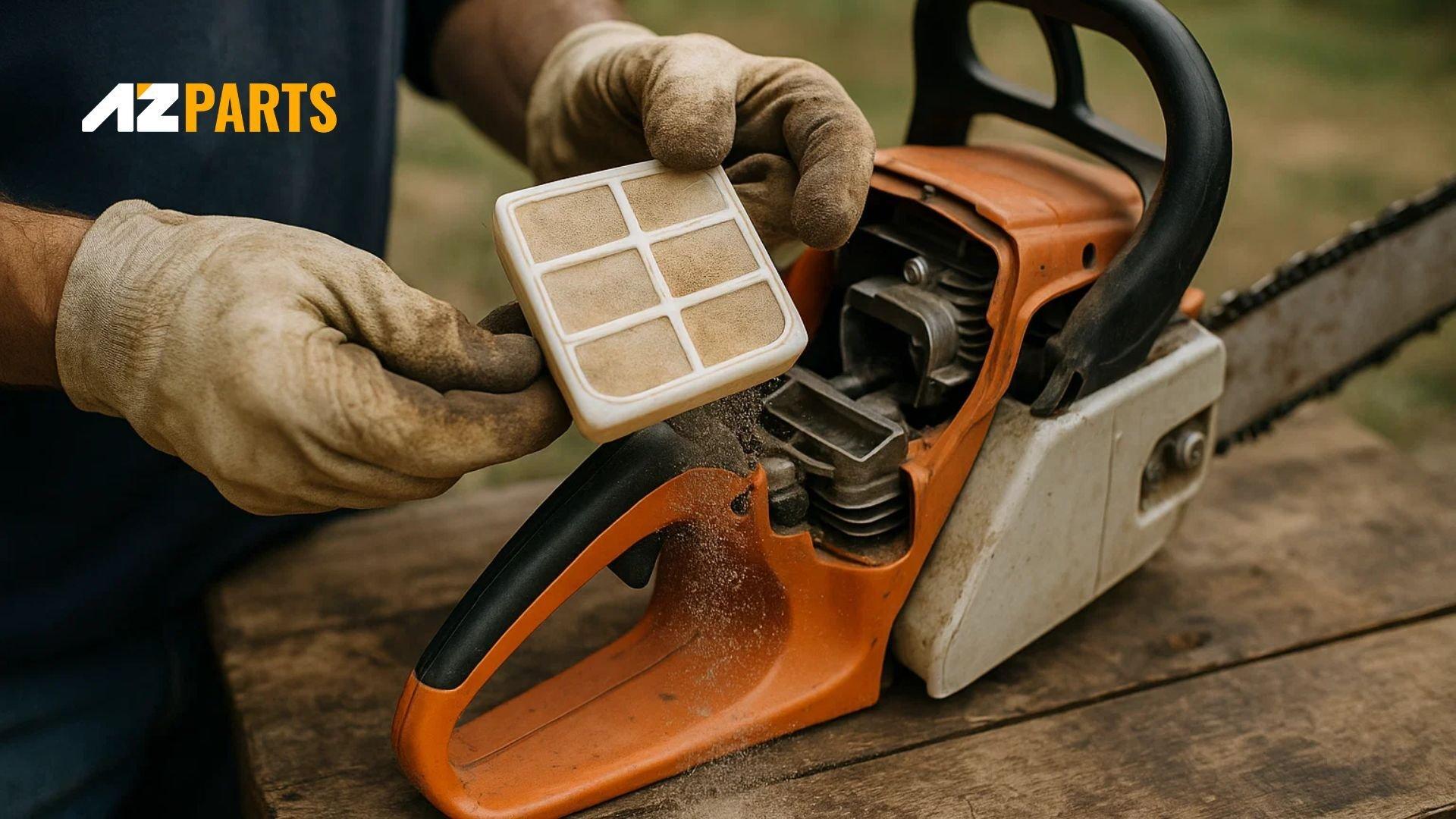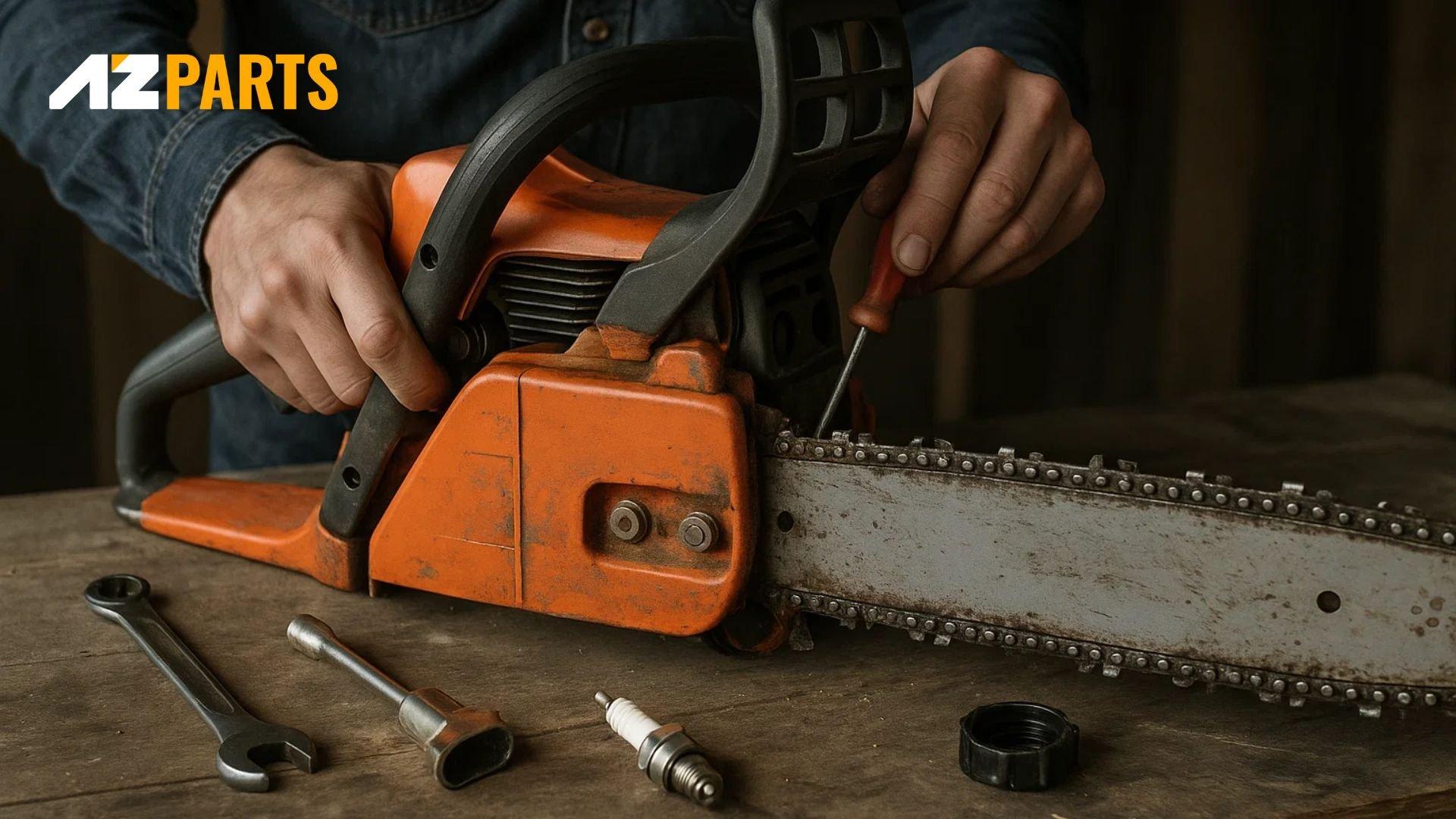Repair help
What to Do With a Chainsaw Not Cutting Straight
AZparts Team
Updated on August 1, 2025
8 min read
A chainsaw not cutting straight is one of the most common issues faced by both professional loggers and weekend warriors alike. This problem not only affects the quality of your work but can also pose safety risks and lead to wasted materials. Through this topic, AZParts will help you understand why your chainsaw veers off course is the first step toward resolving this issue.

1. What Causes a Chainsaw to Cut Crooked?
Several factors can contribute to a chainsaw not cutting straight, ranging from maintenance issues to worn components. Each cause requires a specific approach to diagnosis and repair. Let's examine the most common culprits behind crooked chainsaw cuts.
1.1. Uneven Cutter Teeth
The most frequent cause of crooked cuts is uneven sharpening of the cutting teeth. When some teeth are sharper than others, or when they're filed at different angles, the chain pulls more aggressively on one side. This imbalance causes the saw to drift in the direction of the sharper teeth, resulting in curved or angled cuts instead of straight ones.
Professional chainsaw operators know that maintaining uniform tooth geometry is crucial for straight cuts. Each cutter tooth should have the same length, angle, and sharpness level. Even small variations can significantly impact cutting performance, making it essential to pay attention to detail during sharpening sessions.
The most frequent cause of crooked cuts is uneven sharpening (Source: AZParts)
1.2. Loose Chainsaw Chain
A loose chain is another common culprit behind cutting problems. When the chain lacks proper tension, it can wobble on the bar, causing inconsistent contact with the wood. This wobbling action prevents the chain from following a straight cutting path, leading to wandering cuts that deviate from your intended line.
Chain tension affects not only cutting accuracy but also safety and chain longevity. A properly tensioned chain should have slight give when pulled away from the bar but shouldn't sag noticeably. For reliable chainsaw chains that maintain proper tension longer, AZParts offers premium chainsaw chain parts designed for consistent performance across various chainsaw models.
AZParts offers premium replacement chains (Source: AZParts)
1.3. Chain Too Thin for Bar Groove
Using a chain that's too narrow for your bar's groove creates excessive play, allowing the chain to move laterally during cutting. This lateral movement disrupts the cutting path, causing the saw to wander and produce crooked cuts. The chain should fit snugly in the bar groove without binding or excessive looseness.
Matching chain gauge to bar groove width is fundamental to proper chainsaw operation. Even experienced users sometimes overlook this specification when replacing chains, leading to cutting problems that seem mysterious but have a simple solution. Always verify compatibility between your chain gauge and bar groove specifications.
Chain Too Thin for Bar Groove (Source: AZParts)
1.4. Worn-Out Bar Groove
Over time, the groove in your chainsaw bar can wear unevenly, becoming wider on one side than the other. This uneven wear allows the chain to sit at an angle, causing it to cut in a curved path rather than straight ahead. Bar groove wear is particularly common in heavily used chainsaws that haven't received proper maintenance.
Inspecting your bar groove regularly can help identify wear patterns before they significantly impact cutting performance. A worn groove not only affects cutting accuracy but can also accelerate chain wear and reduce overall cutting efficiency. Professional operators often rotate their bars periodically to ensure even wear distribution.
1.5. Uneven Bar Rails
The rails on top of your chainsaw bar guide the chain during cutting. When these rails become uneven due to wear, damage, or improper filing, they can cause the chain to track improperly. Uneven rails create an unbalanced cutting action that pulls the saw off its intended path, resulting in crooked cuts.
Bar rail maintenance is often overlooked but plays a crucial role in cutting performance. Regular inspection and proper filing of the rails help maintain straight cutting capability and extend the life of both the bar and chain. Professional-grade bars typically offer better wear resistance and maintain their geometry longer under heavy use.
Uneven Bar Rails Can Cause The Chain to Track Improperly (Source: AZParts)
2. How to Fix a Chainsaw That Won't Cut Straight
Once you've identified what's causing your chainsaw to cut crooked, implementing the right solution becomes straightforward. Most cutting problems can be resolved with proper maintenance techniques and attention to detail. Here are the most effective methods for restoring straight cutting performance.
2.1. Sharpening the Chainsaw Chain Properly
Proper chain sharpening is both an art and a science that requires patience and precision. Start by securing your chainsaw in a stable position and engaging the chain brake for safety. Use a round file that matches your chain's specifications, maintaining consistent filing angles and pressure throughout the process.
Each cutter tooth should receive the same number of file strokes at identical angles. Count your strokes carefully and maintain the same filing angle for all teeth on one side before switching to the other side. The depth gauges also need attention – they should be filed to the correct height to ensure proper cutting action and prevent the chain from grabbing too aggressively.
Professional sharpening involves more than just filing the cutting edges. The top plate angle, side plate angle, and depth gauge height all work together to create efficient cutting action. Many users benefit from using filing guides or templates to maintain consistency, especially when learning proper sharpening techniques.
Sharpening the Chainsaw Chain Properly (Source: AZParts)
2.2. Adjust Your Chainsaw Chain's Tension
Proper chain tension adjustment requires a systematic approach to ensure optimal performance. Start with a cool chainsaw, as chain tension changes with temperature. Loosen the bar nuts slightly, then use the tensioning screw to adjust the chain until it fits snugly against the bar bottom while still allowing manual rotation.
The chain should pull away from the bar bottom about 1/8 inch when lifted by hand. After achieving proper tension, hold the bar tip up while tightening the bar nuts to prevent the bar from sagging during the tightening process. Test the tension by rotating the chain manually – it should move freely without binding or excessive resistance.
Regular tension checks become more important as chains stretch with use. New chains typically require several tension adjustments during their first few hours of operation. For reliable replacement parts including chainsaw starter recoils and ignition coils that ensure your saw starts easily for maintenance tasks, AZParts provides quality chainsaw starter recoil and ignition coil components designed for long-lasting performance.
AZParts provides quality chainsaw starter recoil and ignition coil components (Source: AZParts)
2.3. Keep Your Chainsaw Bar Clean
Bar maintenance goes beyond simple cleaning and involves systematic care of all bar components. Remove the chain and bar regularly to clean accumulated debris from the groove and oil holes. Use a specialized bar groove cleaner or thin screwdriver to remove packed sawdust and pitch that can interfere with proper chain operation.
Pay special attention to the oil holes that lubricate the chain during operation. Blocked oil holes reduce lubrication, leading to increased wear and potential binding that affects cutting straightness. Clean these holes with compressed air or a thin wire, ensuring oil can flow freely to all parts of the chain during operation.
The bar rails also require attention during cleaning sessions. File them flat and square to maintain proper chain guidance. Burrs or uneven spots on the rails can cause chain tracking problems that lead to crooked cuts. Regular bar maintenance significantly extends component life and maintains cutting accuracy over time.
3. Preventing Crooked Cuts in the Future
Establishing regular maintenance routines and using quality components helps prevent most cutting problems before they develop. Consistent care practices keep your chainsaw operating at peak performance while extending component life.
Develop a pre-operation inspection routine that includes checking chain tension, examining cutting teeth for damage or dullness, and verifying that the bar is clean and properly aligned. These quick checks can identify potential problems before they affect cutting performance or create safety hazards.
Invest in quality replacement parts when maintenance or repairs become necessary. Premium chains, bars, and other components typically offer better performance and longer service life than budget alternatives. They also maintain their specifications longer under demanding conditions, providing more consistent cutting performance over time.
Preventing Crooked Cuts in the Future (Source: AZParts)
Proper storage practices also contribute to long-term chainsaw performance. Store your saw in a clean, dry location with the chain properly tensioned and the bar covered to prevent damage. Regular maintenance during storage periods helps ensure your chainsaw is ready for reliable service when needed.
A chainsaw not cutting straight doesn't have to end your productive cutting session. By understanding the common causes and implementing proper solutions, you can restore your saw's cutting accuracy and maintain it for years of reliable service. Regular maintenance, proper sharpening techniques, and attention to component condition are key to preventing future problems.
Whether you need replacement chains, bars, or other chainsaw components, AZParts provides the quality chainsaw parts and expert guidance necessary to keep your equipment performing at its best. Don't let cutting problems slow down your work – take action today to restore your chainsaw's straight-cutting capability.
Contact Info
Address: 8 The Green, Ste A, Dover, Delaware 19901-3618, United States
Email: support@azparts.com
chainsaw
Further Reading
Further Reading





